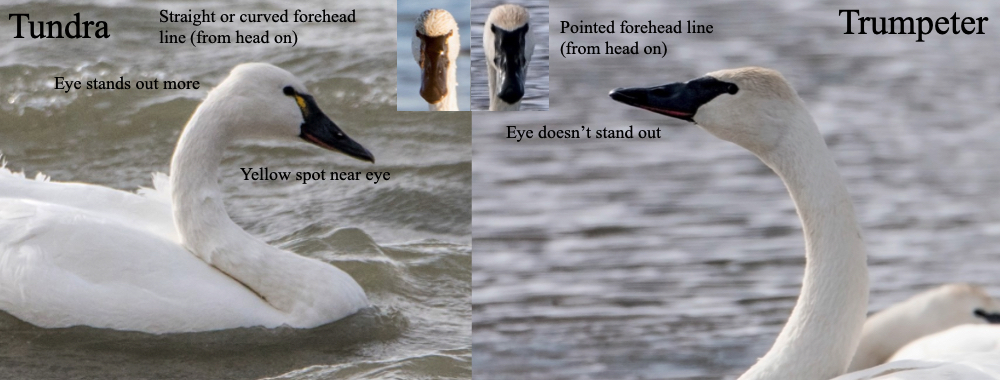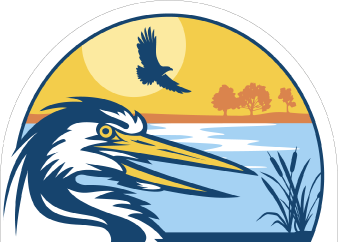
Many times, people wonder what type of swan they are seeing at Iroquois National Wildlife Refuge. Up until several years ago, there was really only one possible North American swan as an answer to these queries: the Tundra Swan, which was formerly named Whistling Swan. However, today, it is possible to see two species of native swans, and one other species, the invasive Mute Swan.
According to eBird, the Tundra Swan is a “Huge white bird with a long elegant neck. North American “Whistling” Tundra Swans have a mostly black bill, with a yellow spot near the eye” and are “Easily confused with the European/Asian Whooper Swan and North American Trumpeter Swans where their ranges overlap.” In Western New York, Tundra Swans are frequently seen in large numbers as they migrate in early spring and late fall. Flocks of Tundra Swans can be seen in fields eating waste corn to build energy for the push to fly to the Arctic tundra. Once they reach northern Canada and Alaska’s North Slope, the strongest of their population get down to the business of nest building, laying eggs and raising their cygnets.
Click here to become a member!
Click here to donate!

Protection of the critical breeding ground for these swans and the many other Arctic mammal and bird species and specialized Arctic plants is the mission of the Arctic National Wildlife Refuge, a national treasure and the largest refuge of the National Wildlife Refuge System.
After the breeding season, we again see large flocks of Tundra Swans heading south for their wintering grounds on fresh or saltwater, accompanied by the immature dusky gray-brown cygnets.

Trumpeter Swans began to make regular appearances in Western New York around the year 2010. Trumpeter Swans are native to the Western United States, but according to the Trumpeter Swan Society website, “In the 1930s, only 69 trumpeters were known to be alive in the United States and those were all in Yellowstone and the Centennial Valley of Montana. That discovery led to the establishment of Red Rock Lakes National Wildlife Refuge. Those birds were sheltered from trapping and hunting due to the remoteness and harshness of the region. Swans were able to survive through the cold in these regions thanks to ice-free areas created by hot springs and geysers. In the late 1930s, biologists began moving some of those trumpeters to other western refuges. Unknown to the U.S. biologists at that time, there was another area, Grand Prairie in Alberta, Canada, where a small flock of trumpeters also survived. Additionally, after Alaska became a state, more trumpeters were discovered, and a survey in the 1960s found more than 2,000 there. This led to trumpeter swans being removed from the U.S. endangered species list in 1968, before the Endangered Species Act of 1973. However, various states list the Trumpeter as either state-threatened or state-endangered.”
According to eBird, Trumpeter Swan is a “Huge white bird with long neck and all-black bill. Immatures dusky gray-brown with pink on bill. Extremely similar to Tundra Swan, but never shows yellow on bill. Also, note subtle features of face: facial skin is relatively broad where it meets eye, so the eye doesn’t stand out, and border between white face and black bill is straight (curved on Tundra). From head-on, the border of the bill and forehead is usually pointed (straight or curved on Tundra).”

Above: Notice the pointed crown feathering and the subtle facial features on this lovely Trumpeter Swan, one of the first seen regularly at Iroquois NWR.

Above: Immature Trumpeter Swan Note the pointed crown feathering, pink saddle on the bill, vertically held neck and rather shallow curve to the back, all helpful in distinguishing from Tundra Swan.
Three years ago, a wing tagged Trumpeter Swan made Iroquois a breeding location choice! Not until the swan, named “K93”, became a fixture here, were trumpeters a breeding species in the area. Since that time, Trumpeter Swans have successfully raised 6 cygnets in 2018, 7 in 2019 and 4 in 2020.

Above: K93 with mate in 2018

Above: Five of the six cygnets reared by K93 and mate in 2018

Above: Male swan K93 sleeping after his arrival back at Iroquois for another breeding year.
For information on swan “K93’s” wing tag, I submitted a report to the USGS Bird Banding Laboratory. The banding lab accepts all wing tag and other band reports. After receiving a response, to find out where this particular swan winters, I also wrote to the Trumpeter Swan Society and received an answer very soon after, telling me more about K93. K93 is a male that hatched in 2013 to swans “E68” and “A74” in Central Ontario. K93 has spent the past four winters near Thorold, Ontario, just 46 miles west of Iroquois. I suspect that K93 is a homebody – He doesn’t seem to venture very far! Actually, these introduced swans will have to learn new migration patterns because they lack the knowledge of traditional migration routes to more southerly wintering areas. The area around Thorold, Ontario is adjacent to the Welland Canal and several conservation parks that must provide enough food and shelter for the swans to survive in winter.
Above: Trumpeter Swan Cygnus buccinator ©Celeste Morien 16 Oct 2020 Iroquois NWR—Kumpf Marsh, Genesee, New York, US Note: Listen for the vocal “oh-OH” trumpeting calls.

Above: These five swans show typical staining on their necks resulting from vegetation when feeding in shallow marshes. Undoubtedly, some of K93’s offspring.
In the spring of 2020, for the first time at Iroquois NWR, several Mute Swan (Cygnus olor) were seen. Hopefully these invasive and very aggressive swans, native to Europe and Asia, will not make Iroquois a breeding location. These unwelcome swans are highly territorial and drive away native waterfowl and waterbirds from their territories, and do not allow other species to nest nearby, reducing the amount of habitat other native birds have to reproduce. Adult Mute Swans are recognized by a black knob on top of their orange bill.

Above: Adult Mute Swan Note the pointed tail, which along with the orange bill, distinguishes it from our native swans.

Above: Four out of eight cygnets survived this year, with K93 and his mate

It is hoped that K93 will continue to make a home at Iroquois NWR and delight refuge visitors because of his impressive size and hey, because people just love swans!
The Swan
Did you too see it, drifting, all night, on the black river?
Mary Oliver
Did you see it in the morning, rising into the silvery air –
An armful of white blossoms,
A perfect commotion of silk and linen as it leaned
into the bondage of its wings; a snowbank, a bank of lilies,
Biting the air with its black beak?
Did you hear it, fluting and whistling
A shrill dark music – like the rain pelting the trees – like a waterfall
Knifing down the black ledges?
And did you see it, finally, just under the clouds –
A white cross Streaming across the sky, its feet
Like black leaves, its wings Like the stretching light of the river?
And did you feel it, in your heart, how it pertained to everything?
And have you too finally figured out what beauty is for?
And have you changed your life?

